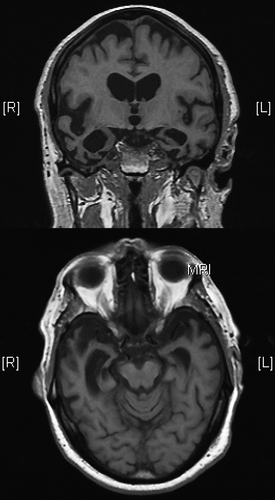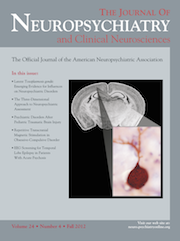Loss of Meaning for “Marriage” in Semantic Dementia
To the Editor: Semantic dementia (SD) is a neurodegenerative disorder characterized by the loss of meaning for words, faces, or concepts. We present a rare case of SD in a patient who lost the meaning for the concept of marriage.
Case Report
A 68-year-old, right-handed man had a 4-year history of progressive inability to identify words, familiar faces, and concepts. His wife described loss of the meaning of calendar dates such as Valentine's day, his religious events, and gestures and sign language. He responded with a perplexed “What is it?” when confronted with these concepts. His personality had become outgoing, emotionally unaware, rigid in his routines, and inattentive to his self-care. Over the next 2 years, he progressed to inability to recognize foods and smells.
Most recently, his loss of concepts extended to the meaning of “marriage.” He understood that his “wife” was a close family member, but did not recognize their relationship as that of a husband and wife, to the point of accepting her living in the same house with another man. When asked about the meaning of “marriage,” he responded with “What is marriage?”
On examination, the patient demonstrated semantic deficits. He scored 27/30 on the Mini-Mental State Exam. Language was fluent, with good sentence comprehension, but, on the mini-Boston Naming Test, he failed to name 9 of 15 items, and, when presented with the missed names, was unable to comprehend the words. He had particular difficulty recognizing animate items. On reading, he had difficulty with irregular words and made regularization errors, and, on a face recognition test, he failed to identify 15 of 20 famous faces. The rest of the neurologic examination was intact. Magnetic resonance imaging (MRI) showed severe atrophy of both anterior temporal lobes, most prominent on the right (see Figure 1).

Discussion
This patient has SD with semantic anomia, surface dyslexia, prosopagnosia, difficulty identifying living things, and other semantic deficits. His semantic loss extends to the concept of “marriage.” This loss has fundamentally altered his relationship with his wife in his own home.
SD affects the anterior, inferolateral temporal lobes, a “convergence zone” for semantic concepts.1,2 The earliest and most common semantic deficit in SD is semantic anomia,2 or the loss of meaning of words. The deficits in SD, however, extend beyond language, to involve a multimodal loss of the meaning of objects, faces, smells, or more abstract concepts.3 In SD, left temporal involvement particularly affects the semantics of language, and right temporal involvement particularly affects the recognition of faces and living things.4
This report describes a patient with SD who lost his sense of the meaning of marriage. His loss of semantic knowledge affected concepts involving interpersonal interactions, customs, and ceremonies. Investigators report that right anterior temporal dysfunction, which was particularly notable in this patient, impairs social concepts,5 and it is possible this region is necessary for concepts of human relationships, such as marriage. Future studies in SD can profitably focus on the organization of semantic knowledge for interpersonal relationships in the brain.
1 : Semantic dementia: demography, familial factors, and survival in a consecutive series of 100 cases. Brain 2010; 133:300–306Crossref, Medline, Google Scholar
2 : What is semantic dementia?: a cohort study of diagnostic features and clinical boundaries. Arch Neurol 2010; 67:483–489Crossref, Medline, Google Scholar
3 : Where do you know what you know? the representation of semantic knowledge in the human brain. Nat Rev Neurosci 2007; 8:976–987Crossref, Medline, Google Scholar
4 : Interhemispheric differences in knowledge of animals among patients with semantic dementia. Cogn Behav Neurol 2010; 23:240–246Crossref, Medline, Google Scholar
5 : Social conceptual impairments in frontotemporal lobar degeneration with right anterior temporal hypometabolism. Brain 2009; 132:604–616Crossref, Medline, Google Scholar



